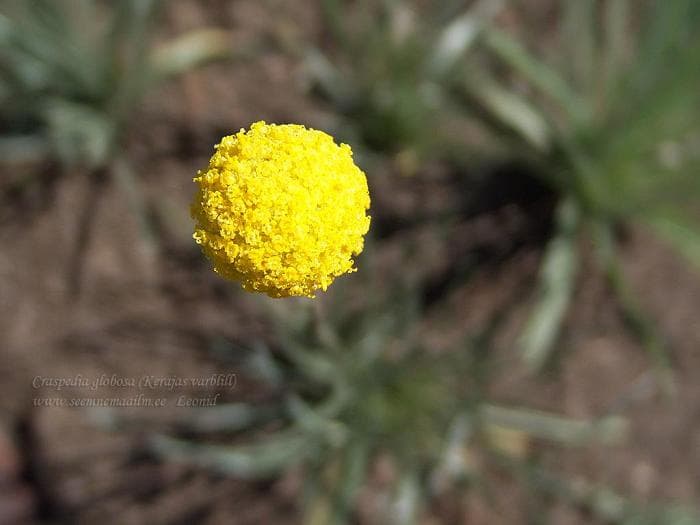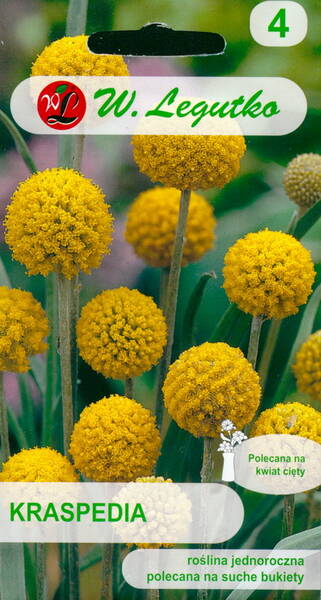Your shopping cart is empty!
Drumstick Billy Button
Drumstick Billy Button - Craspedia globosa.
The brilliant yellow hue and dense spherical shape of Craspedia globosa make it a striking addition to both fresh and dried arrangements.
Known as the "billy button" or "drumstick". A relatively new plant for flower growers, brought from Australia only in the 80s of the XX century.
In culture, only one species is known: Craspedia globular - Craspedia globosa.
The original inflorescence, similar in shape to a ping-pong ball, allowed craspedia to quickly gain popularity, despite the fact that this plant from the natural flora of Australia was recently introduced into culture.
Herbaceous perennial plant grown as an annual. 50-70 cm high, with straight leafless stems. Spherical inflorescences with a diameter of 2.5-3 cm are yellow. Blooms in August - September.
When the inflorescence dries, the peduncles become very durable and not damaged, even if they do not hit the hard surface very hard. For this, flower growers call craspedia “drumsticks”.
Location: the plant is moisture-loving, cold-resistant and photophilous, blooms with a short day.
Care: watering at the beginning of growth and in dry weather is required. Top dressing after planting, first with nitrogen (2-3 times) and then with full complex fertilizers, enhance flowering.
Reproduction: seeds, in 1 g about 1500 pcs. To obtain 100 plants, you need 0.2 g of seeds. Sow in February and put in a bright place.
Seedlings are planted in May with a distance of 25-30 cm between plants.
Billy Button is a short-day plant, therefore, even with early sowing, flowering begins only in the second half of August.
At the same time, mass flowering occurs in September, and with the early onset of cold weather, very little cut is obtained.
To obtain more cut, craspedia can be grown in greenhouses, both film and glass.
Film greenhouses allow to extend the flowering period until October, which significantly increases the cut yield.
In winter greenhouses, craspedia can be sown in November, with flowering beginning in May and continuing until next November.
Usage: plants are intended for dry bouquets and less often for fresh cut. The inflorescences are cut in full bloom and dried in bunches in a dry ventilated area.
The brilliant yellow hue and dense spherical shape of Craspedia globosa make it a striking addition to both fresh and dried arrangements.
Known as the "billy button" or "drumstick". A relatively new plant for flower growers, brought from Australia only in the 80s of the XX century.
In culture, only one species is known: Craspedia globular - Craspedia globosa.
The original inflorescence, similar in shape to a ping-pong ball, allowed craspedia to quickly gain popularity, despite the fact that this plant from the natural flora of Australia was recently introduced into culture.
Herbaceous perennial plant grown as an annual. 50-70 cm high, with straight leafless stems. Spherical inflorescences with a diameter of 2.5-3 cm are yellow. Blooms in August - September.
When the inflorescence dries, the peduncles become very durable and not damaged, even if they do not hit the hard surface very hard. For this, flower growers call craspedia “drumsticks”.
Location: the plant is moisture-loving, cold-resistant and photophilous, blooms with a short day.
Care: watering at the beginning of growth and in dry weather is required. Top dressing after planting, first with nitrogen (2-3 times) and then with full complex fertilizers, enhance flowering.
Reproduction: seeds, in 1 g about 1500 pcs. To obtain 100 plants, you need 0.2 g of seeds. Sow in February and put in a bright place.
Seedlings are planted in May with a distance of 25-30 cm between plants.
Billy Button is a short-day plant, therefore, even with early sowing, flowering begins only in the second half of August.
At the same time, mass flowering occurs in September, and with the early onset of cold weather, very little cut is obtained.
To obtain more cut, craspedia can be grown in greenhouses, both film and glass.
Film greenhouses allow to extend the flowering period until October, which significantly increases the cut yield.
In winter greenhouses, craspedia can be sown in November, with flowering beginning in May and continuing until next November.
Usage: plants are intended for dry bouquets and less often for fresh cut. The inflorescences are cut in full bloom and dried in bunches in a dry ventilated area.

Eng.: Drumstick (Billy Button). Suom.: Kultahehku. Sven.: Solboll.











